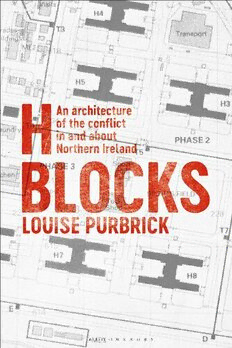
H Blocks: An architecture of the conflict in and about Northern Ireland PDF
217 Pages·2023·75.792 MB·English
Most books are stored in the elastic cloud where traffic is expensive. For this reason, we have a limit on daily download.
Preview H Blocks: An architecture of the conflict in and about Northern Ireland
Description:
A place of incarceration and liberation, political debate and historical denial, the H Block cell units of Long Kesh/Maze prison in Northern Ireland housed members of both Republican and Loyalist military groups during ‘The Troubles’ and are now considered ‘icons’ of that conflict. The H Block’s dual status as an articulation of and resistance against power mean that the area is still one of the most contested sites of conflict in Europe.Based on a long-standing site-specific investigation, and drawing on a range of sources from architectural plans to photographs of street protests, H Blocks explores the material relationship between the prison as a built articulation of power and its inhabitants, highlighting the ethical and political roles that architecture can play in situations of conflict. It also addresses the afterlife of such sites after the end of conflict and how they can adapt to the changing cultural meanings of their space.The book demonstrates how the conflicted histories of the prison are configured in its design and destruction, and the inhabitation and attempted preservation of the site itself, revealing how its architecture is bound up with questions of power and resistance, embodiment and attachment, witnessing and remembering, the materiality of history and its commodification.H Blocks is about the power of architecture and image. It examines the spaces of the H shaped cell units of Long Kesh/Maze prison and how they were inhabited. It is an exploration of the material relationships of political imprisonment in a British jail in Ireland. In its various phases, from architectural plan to post-ceasefire ruin, the H Blocks are a material form of conflict in and about Northern Ireland that carried a highly significant symbolic load. Representations of the H Blocks are integral to the struggle over their meaning, part of their history and historical record. But H Blocks is not an official history. Its sources are the site itself, the voices of prisoners and prison visitors and an array of images and objects that comprise the material culture of Long Kesh/Maze. Each chapter explores a fragment of its material record: the design of the H Blocks, the resistance from its cells, the global witnesses to the oppression of imprisonment, the female visitors and war of waiting, the murals of a liberated zone and the sale of material culture of Long Kesh/Maze. Each chapter also offers a different theoretical lens through which to understand these fragments: panopticism and its critique, dwelling perspectives, necropolitics and the rights-bearing body, a feminist spatial theory and the practice of writing, performativity, the appropriations of commodity culture and agency of objects.
See more
The list of books you might like
Most books are stored in the elastic cloud where traffic is expensive. For this reason, we have a limit on daily download.
